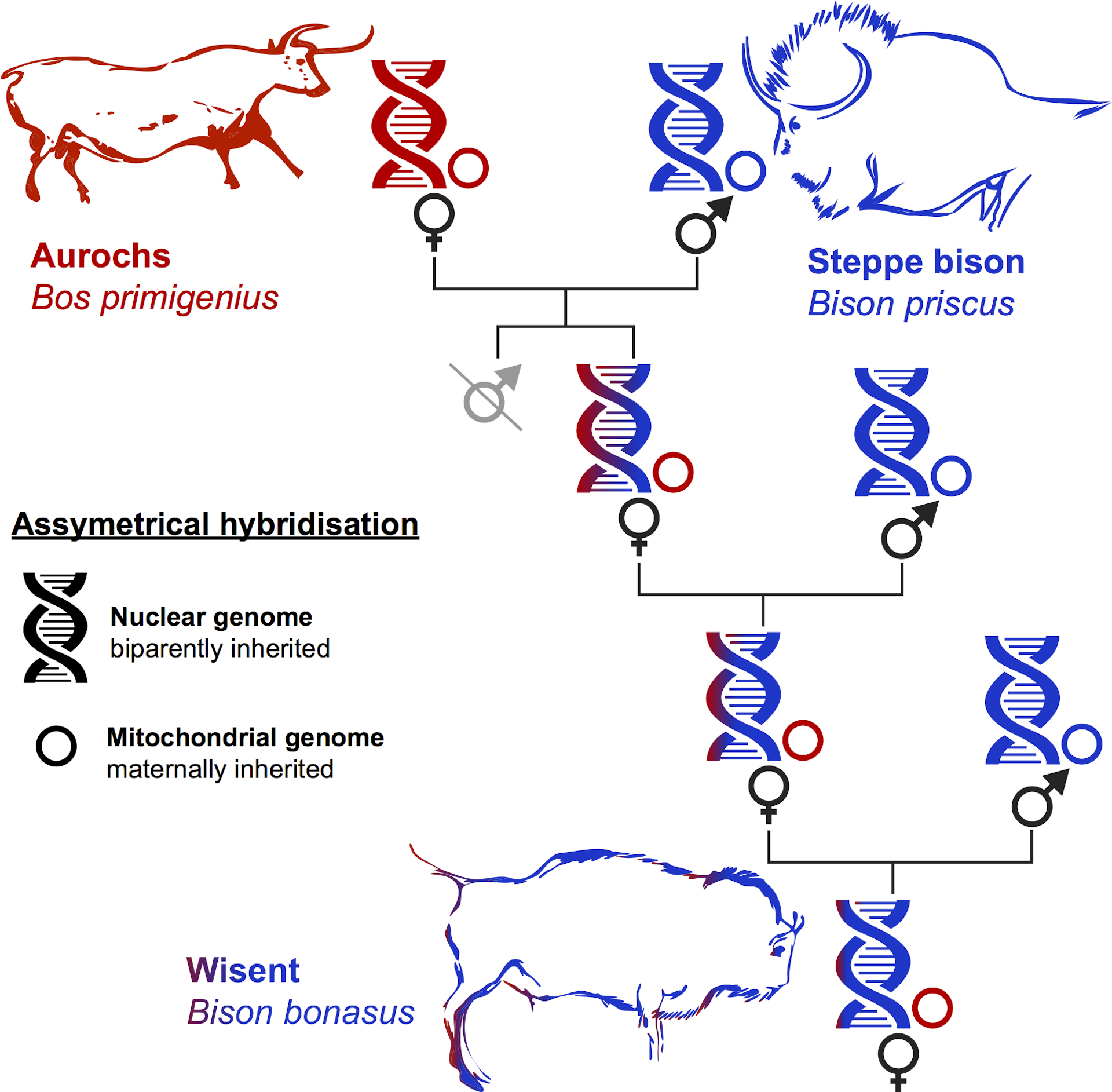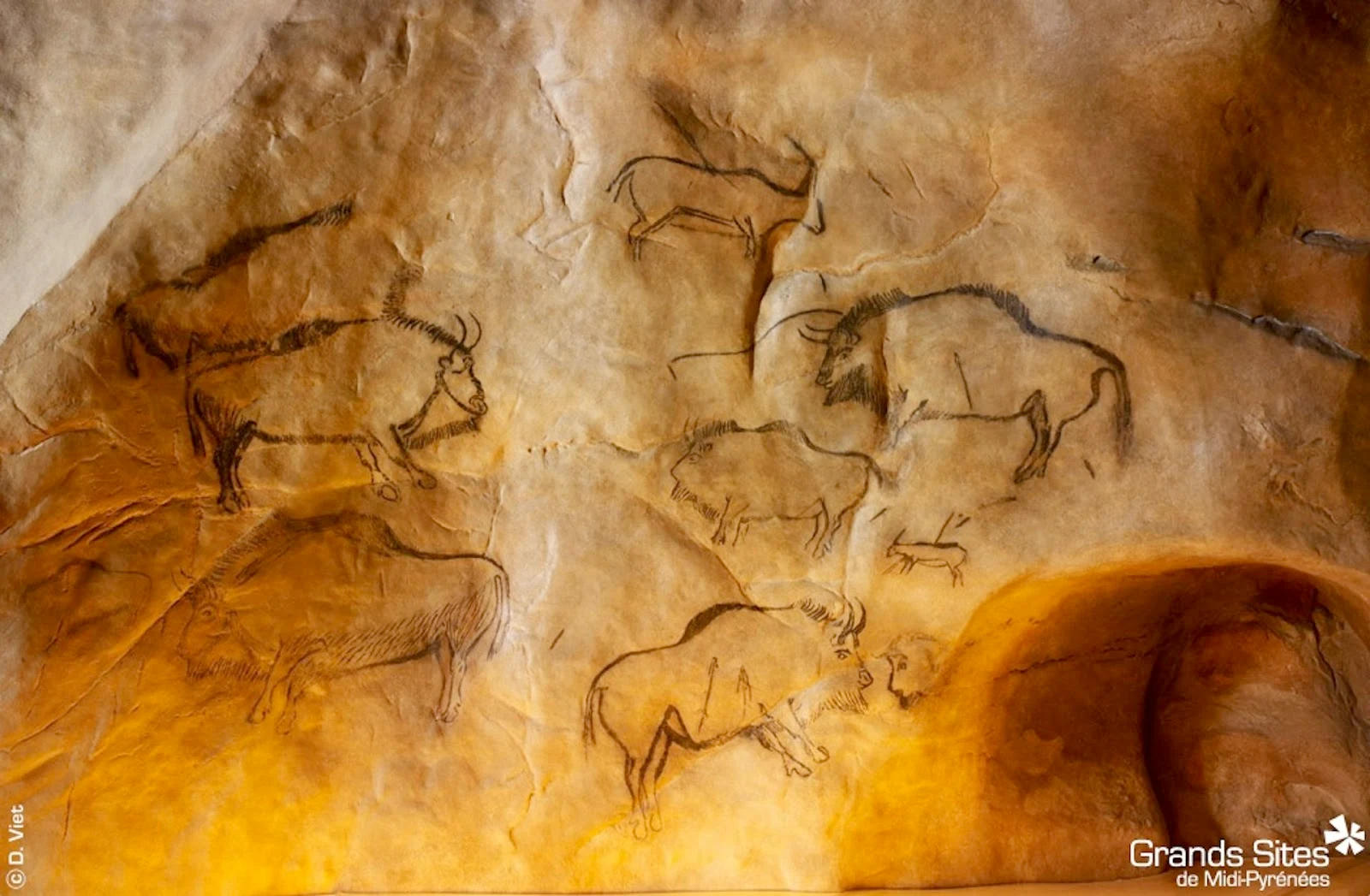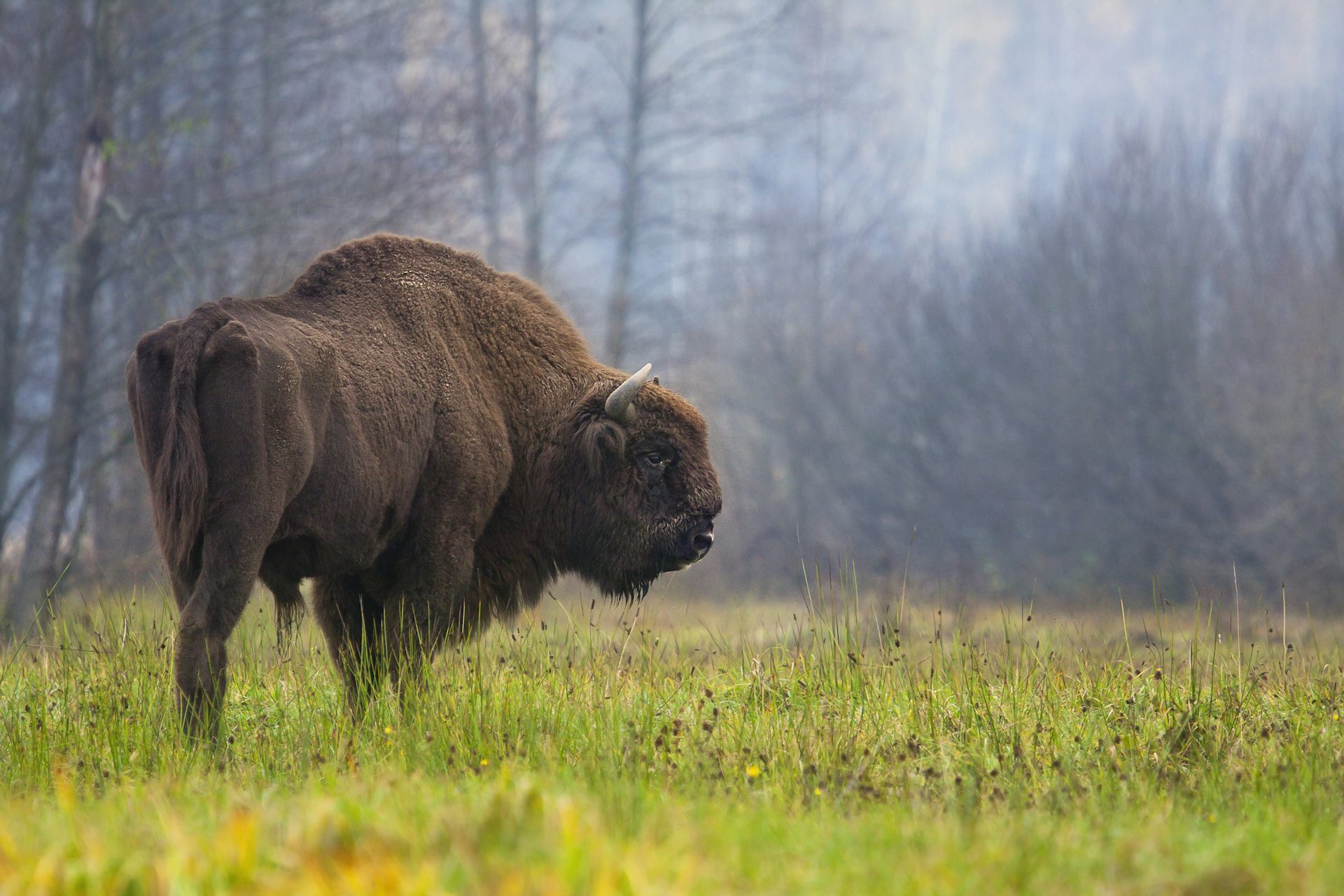Early cave art and ancient DNA record the origin of European bison | Nature Communications.

Black painting of bison (putative European bison, or wisent) at Grotte de Niaux (Niaux cave in Ariège, France), dated to the Magdalenian period (~17,000 years ago).
Photo credit: via University of Adelaide (under Creative Commons licence)
For a creationist claim, the assertion that no new species have been seen to evolve takes some beating for its sheer denial of the readily available data. Now geneticists working at the Australian Centre for Ancient DNA at the University of Adelaide, have shown that even the Stone Age painters of the caves such as Lascaux Cave, France, captured one such event in their art. Their findings were published yesterday in Nature Communications.
There are three types of bovines captured in these paintings:
- The extinct auroch - the ancestor of the modern domestic cattle, with its long horns and relatively small haunches.
- The large-haunched small-horned steppe bison which was common across the Eurasian and North American grasslands (the North American buffalo).
- A third species with the steppe bison's heavy haunches and the auroch's long horns.
The team have now shown that this third type was derived from a stable hybrid between the auroch and the steppe bison and eventually became the European bison or wisent. In other words, what was captured in these cave paintings was the emergence of a new species which arose by hybridization. As the climate oscillated back and forth, this new species and the steppe bison changed places as the dominant bovine species in Europe.
Abstract
The two living species of bison (European and American) are among the few terrestrial megafauna to have survived the late Pleistocene extinctions. Despite the extensive bovid fossil record in Eurasia, the evolutionary history of the European bison (or wisent, Bison bonasus) before the Holocene ( <11.7 thousand years ago (kya)) remains a mystery. We use complete ancient mitochondrial genomes and genome-wide nuclear DNA surveys to reveal that the wisent is the product of hybridization between the extinct steppe bison (Bison priscus) and ancestors of modern cattle (aurochs, Bos primigenius) before 120 kya, and contains up to 10% aurochs genomic ancestry. Although undetected within the fossil record, ancestors of the wisent have alternated ecological dominance with steppe bison in association with major environmental shifts since at least 55 kya. Early cave artists recorded distinct morphological forms consistent with these replacement events, around the Last Glacial Maximum (LGM, ∼21–18 kya).
Introduction
The extensive Late Pleistocene fossil record of bovids in Europe consists of two recognized forms: the aurochs (Bos primigenius), ancestor of modern cattle, and the mid/late Pleistocene ‘steppe bison’ (Bison priscus), which also ranged across Beringia as far as western Canada1,2. The European bison, or wisent (Bison bonasus), has no recognized Pleistocene fossil record and seems to suddenly appear in the early Holocene (<11.7 kya)3,4, shortly after the disappearance of the steppe bison during the megafaunal extinctions of the Late Pleistocene5,6,7. The Holocene range of wisent included all lowlands of Europe, and several highland areas of eastern Europe (where it was termed the Caucasian form B. bonasus caucasicus) but range reduction and hunting by humans brought the species close to extinction, with modern populations descending from just 12 mostly Polish individuals that lived in the 1920s (refs 8, 9). Nuclear DNA sequences and the morphology of the wisent show close similarities to American bison (B. bison), but wisent mitochondrial DNA (mtDNA) indicates a closer relationship with cattle. This suggests some form of introgression from cattle or a related Bos species10,11,12, potentially associated with the recent extreme bottleneck event.
Both aurochs and bison feature heavily in Palaeolithic cave art, with 820 depictions displaying bison individuals (∼21% of known cave ornamentation13). The diversity of bison representations has been explained as putative cultural and individual variations of style through time, since the steppe bison was assumed to be the only bison present in Late Paleolithic Europe14,15,16. However, two distinct morphological forms of bison (Fig. 1, Supplementary Information section) are clearly apparent in cave art: a long-horned form similar to modern American bison (which are thought to be descended from steppe bison), with very robust forequarters and oblique dorsal line, and a second form with thinner double-curved horns, smaller hump and more balanced body proportions, similar to wisent. The former is abundant in art older than the Last Glacial Maximum (LGM, ∼22–18 kya), while the latter dominates Magdalenian art (∼17–12 kya, see Supplementary Information section). Similarly, two distinct morphological forms of Late Pleistocene bison have been reported from North Sea sediments17.To further examine the potential existence of a previously unrecognized fossil bison species within Europe, we sequenced ancient mtDNA and nuclear DNA from bones and teeth of 64 Late Pleistocene/Holocene bison specimens.Figure 1: Cave painting example of steppe bison-like and wisent-like morphs.(a) Reproduction from Lascaux cave (France), from the Solutrean or early Magdalenian period (∼20,000 kya).
(b) Reproduction from the Pergouset cave (France), from the Magdalenian period (<17,000 kya—picture adapted from ref. 54).
We reveal that the wisent lineage originated from hybridization between the aurochs and steppe bison, and this new form alternated ecologically with steppe bison throughout the Late Pleistocene and appears to have been recorded by early cave artists.
Soubrier J., et al
Early cave art and ancient DNA record the origin of European bison.
Nature Communications, 2016; 7: 13158 DOI: 10.1038/ncomms13158
Copyright © 2016 The Authors. Published by Nature Publishing Group. Open acccess.
Reprinted under Creative Commons Attribution 4.0 International License (CC BY 4.0)
The team analysed both mitochondrial and nuclear DNA recovered from a large number of bison bones carbon-dated to different periods and found many with a distinct genetic signal which suggested a third species existed. However, it was not until French cave painting experts were consulted that they discovered that not only were there the three types of cattle depicted but that their occurrance in art of known dates corresponded with the carbon-dated ages of the different genomes, and these in turn corresponded with changes in weather patterns.
This hybrid species is the ancestor of the European bison which went through a very narrow genetic bottleneck in the 1920, only narrowly avoiding extinction with a population of just 12 individuals.
More detail is given in an article in The Conversation by two of the paper's authors, Alan Cooper, Director, Australian Centre for Ancient DNA, University of Adelaide and Julien Soubrier, Researcher in paleogenomics, University of Adelaide. Their article is reprinted here und a Creative Commons license, reformatted for stylistic consistency:

How we discovered the ‘Higgs bison’, hiding in plain sight in ancient cave art
Cave artists knew about the elusive bison some 17,000 years ago.
Alan Cooper, University of Adelaide and Julien Soubrier, University of AdelaideD. Viat/Tourismeoccitanie/Flickr.com, CC BY
More than 30,000 years ago, early cave artists in what is now southwestern France ventured deep underground into limestone caves, where they painted elaborate and detailed frescoes of the huge animals that dominated their lives. The accuracy of the depictions was remarkable – far better than most of us could manage crouched under a sloping damp wall under the flickering light cast by flaming bundles of vegetation and fat.
The paintings record a world of cave lions, mammoth, bison and horses, which we are only just beginning to unravel using the combined technologies of ancient DNA and radiocarbon dating. The results show that despite studying cave art for hundreds of years, we have been blind to some of the important stories the artists were telling.
Our research is a case in point. We have used ancient DNA from fossil bones to deduce the existence of a newly discovered bison species – only to discover that it was already recorded on the walls of caves across Europe, such as in Niaux Cave in southwestern France 17,000 years ago.
DNA detective story
In 1999, we began studying DNA from ancient bison bones found across the northern hemisphere, where Steppe bison had ranged from modern-day Britain to Mexico during the late Ice Age. Our aim was to study the impacts of climate change on animal populations, and sure enough we quickly found that in North America, populations of bison collapsed dramatically around the Last Glacial Maximum (between about 18,000 and 21,000 years ago).
This was well before humans arrived in North America, and it was the first clear demonstration of the key role played by climate change in the extinctions of bison, along with a range of other large species collectively known as “megafauna”.
We have since expanded this study into South America, to reveal that rapid warming events were the critical factor in the demise of many megafaunal species, often with an important finishing touch applied by human hunters.
In Europe, however, our early studies of ancient bison DNA were perplexing. By studying mitochondrial DNA, which is inherited exclusively through the maternal line, we realised that many of the bones were clearly not from Steppe bison, although this was the only species thought to have been in Europe before 10,000 years ago.
Instead, we realised we were looking at something novel: a species distantly related to today’s cattle and to the modern European bison, or wisent - which survives in a few protected forests in Europe, particularly Białowieża Forest between Poland and Belarus.
The little-known wisent is remarkable – the largest native species in Europe, but with a fossil record that goes back only 10,000 years. It almost became extinct after World War I following the collapse of hunting protections enforced by Polish and Russian royalty. Indeed, modern herds are descended from just 12 individuals, including one bull from the Caucasus, where the last wild wisent was shot in 1927.
Since the DNA from our ancient bones was neither Steppe bison nor wisent, we appeared to have found a new species - or had we? We started referring to it as the “Higgs bison”, because – just like the elusive Higgs boson which physicists spent decades tracking down – we had surmised the existence of something without knowing what it looked like.
On the trail
The first thing we needed to do was to confirm our mitochondrial DNA results with nuclear DNA, which is harder to retrieve from ancient bones but records all aspects of ancestry, rather than just maternal inheritance.
The nuclear DNA showed our Higgs bison was a hybrid – a cross between a female Aurochs, the extinct wild ancestor of modern cattle, and a male Steppe bison. We dated this hybridisation to more than 120,000 years ago.
Interestingly, this ancestry was the same for modern European bison, and even though the mitochondial DNA looked different (probably due to the recent population bottleneck), the Higgs bison was revealed as the ancestor of the wisent.
Describing the search for the missing bison.
Male offspring of the Aurochs/Steppe bison union were sterile, as is common for mammal hybrids. As a result, several generations of females back-crossed with Steppe bison males (maybe even the same bull), resulting in a genetic ancestry of about 10% Aurochs and 90% Steppe bison.
After this initial interchange with the parental species, the Higgs bison went solo and never looked back - surviving the next 120,000 years, the arrival of modern humans, the megafaunal extinctions, World War I and the Communist revolution along the way. (If there ever needs to be an animal symbol of European history, we have a winner!).

Genetics and cave art reveal the assymetric hybridisation between female aurochs and male Steppe bison. Male hybrid offspring are sterile, and female offspring backbred with Steppe Bison for several generations - possibly the same bull.
Dutch colleagues reported that among the many Steppe bison and Aurochs bones dredged from the North Sea they had noticed another, less common, smaller animal. Meanwhile, French cave art researchers replied that they had noticed that among the cave drawings were two distinct forms of bison: a wedge-shaped one with big horns, rather like a modern American bison; and a more evenly shaped animal with smaller horns, like a modern wisent.
This is where the story comes full circle. Radiocarbon dating of the artworks showed that the wedge-shaped form was drawn when Steppe bison were present on the landscape (around 18,000 years ago), while the small-horned version was drawn when our new species dominated Europe (after 17,000 years ago). Each species appears to have dominated Europe for long periods of time, alternating in response to major climate changes.
Overall, this investigation has thrown up many surprises. Apparently, mammals can form new species by hybridisation, even if only rarely. It also shows that despite the huge bison fossil record, and helpful drawings of both species displayed on cave walls, it took us until now to get the story straight.
How many other species are still hiding in plain sight, helpfully catalogued by prehistoric cave artists?
Alan Cooper, Director, Australian Centre for Ancient DNA, University of Adelaide and Julien Soubrier, Researcher in paleogenomics, University of Adelaide
This article is republished from The Conversation under a Creative Commons license. Read the original article.
In a way, you have to pity poor creationists having to work so hard to dismiss this sort of evidence to keep tryign to convince themselves that it isn't there and what it produced disn't happen, through fear of what an imaginary mind-reading thug in the sky might think.
So, what we can now expect, if they don't simply avoid it altogether, is the traditional moving of the goal-posts as creationists change their claim from no new species to no new genuses.
What Makes You So Special? From The Big Bang To You
How did you come to be here, now? This books takes you from the Big Bang to the evolution of modern humans and the history of human cultures, showing that science is an adventure of discovery and a source of limitless wonder, giving us richer and more rewarding appreciation of the phenomenal privilege of merely being alive and able to begin to understand it all.
Available in Hardcover, Paperback or ebook for Kindle
Ten Reasons To Lose Faith: And Why You Are Better Off Without It
This book explains why faith is a fallacy and serves no useful purpose other than providing an excuse for pretending to know things that are unknown. It also explains how losing faith liberates former sufferers from fear, delusion and the control of others, freeing them to see the world in a different light, to recognise the injustices that religions cause and to accept people for who they are, not which group they happened to be born in. A society based on atheist, Humanist principles would be a less divided, more inclusive, more peaceful society and one more appreciative of the one opportunity that life gives us to enjoy and wonder at the world we live in.
Available in Hardcover, Paperback or ebook for Kindle








In fairness, one cannot expect modern creationists to show the same level of common sense as stone-age cave men did. The latter may well have had some sort of religion, but it hadn't developed to the point of brainwashing them to pretend they couldn't see anything that didn't fit their world-view. They simply painted the world as it appeared to them.
ReplyDeleteI can just imagine a modern fundamentalist's reaction to all these bison references. "Bison? If I had a bison, I'd send him to reparative therapy to turn him completely straight!"